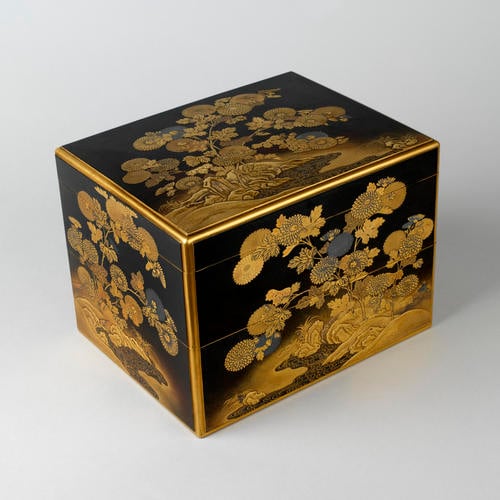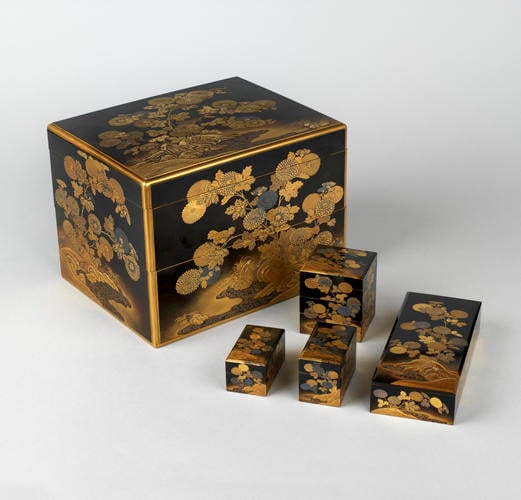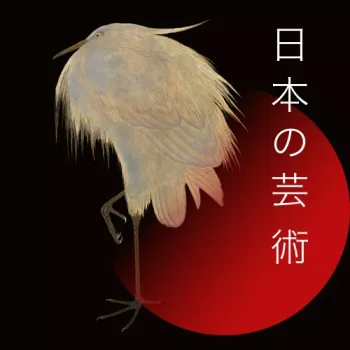Box for an incense game (kōbako) eighteenth century
Black, gold and silver lacquer on wood | 17.0 x 23.0 x 18.0 cm (whole object) | RCIN 3484
-
Incense was introduced to Japan from mainland Asia during the sixth century, and its appreciation quickly became a mark of refinement. During the Muromachi period (1391–1573) ‘the way of incense’ (kōdō) emerged as a fashionable aristocratic activity governed by strict rules of etiquette, alongside the tea ceremony (chanoyu) and flower arranging (ikebana). Rare incense woods were collected and burned on special occasions, or associated with particular poetic moods and scenes from classical literature like the Tale of Genji. By the mid-Edo period, elaborate incense games had become formalised and divided into separate schools. Sets of matching utensils in lavish lacquer boxes were included in the bridal trousseaux of women from daimyō families. These wares were also increasingly enjoyed by wealthy merchants and chōnin (townspeople).
This set contains some of the equipment required for an incense game called jishū-ko (literally ‘ten types of incense’). Before the competition begins, three different kinds of incense wood are burned and named for the guests. Then follow ten rounds in which the master of ceremonies burns small pieces while the guests try to identify each, recording their answers on paper slips. The rounds include three of each of the original types of incense, as well as one piece of a fourth kind, the ‘guest incense’ (kyaku-ko).
Within this lacquer box (kōbako) are counters, paper pouches for answer slips, a bamboo pot with assorted utensils for lighting the wood and a sectioned tray with silver chrysanthemum-shaped studs for placing small mica plates holding the heated incense. Larger sets might include a box for players to insert their answers, writing equipment for record-keeping and tools for cutting the incense wood.
Inside, for gaming use, an oblong box and three smaller boxes, their tops and sides decorated en suite. The oblong box, RCIN 4681, holds ten small boxes, each with eight black counters, each painted with a gilt numeral and a flower spray on the reverse. Also inside, a shallow oblong tray, decorated in gold and silver with drifting clouds, and inlaid with 12 chrysanthemum bloom studs in solid silver. In the lower tier, a square three-tiered box, RCIN 29458, lined with white metal, and two small rectangular boxes, RCIN 29456 and 29457, one of which is similarly lined.
Text adapted from Chinese and Japanese Works of Art in the Collection of Her Majesty The Queen: Volume III and Japan: Courts and Culture (2020)Provenance
Almost certainly presented to Prince Alfred, Duke of Edinburgh by the Emperor Meiji during his visit to Japan in 1869.
Lent for exhibition at the South Kensington Museum in 1872 (The Cruise of His Royal Highness the Duke of Edinburgh, K.G. round the World in H.M.S. "Galatea"..., cat. no. 559).
Possibly identifiable in an image of the Indian Room at Clarence House, c.1870-80 (RCIN 2102090) during the time of the Prince's occupancy and certainly displayed there in 1875 (Catalogue of the Collection of ... Specimens of Oriental Art formed by H.R.H. the Duke of Edinburgh ... Also, the collection of ... objects of art and vertu, at Clarence House, St. James's, 1875' p.22).
Loaned to the Fine Art Society Exhibition of Japanese Art in 1888 (cat. no. 1)
Loaned to the Bethnal Green Museum with other items from the 'Saxe Coburg Collection' on 3 June 1901 (no.615). -
Creator(s)
(nationality)Acquirer(s)
-
Medium and techniques
Black, gold and silver lacquer on wood
Measurements
17.0 x 23.0 x 18.0 cm (whole object)
Category
Object type(s)
Place of Production
Japan










